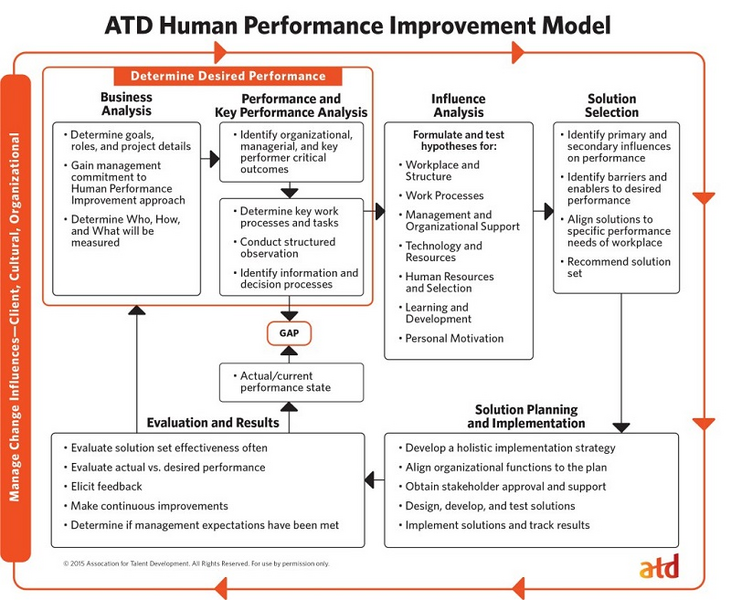ATD Blog
A Better Blueprint for Performance Improvement
Wed May 11 2022

Human performance improvement is the core of the talent development profession.
According to the Talent Development Capability Model, “Performance improvement is a holistic and systematic approach to meeting organizational goals by identifying and closing human performance gaps. It is a results-based effort that includes the ability to analyze root causes of performance issues, plan for future improvements in human performance, and design and develop solutions to close performance gaps.”
“Performance improvement starts with the end in mind: the desired business results,” notes Geri Lopker, business coach and founder of Geri Lopker and Associates, in the ATD blog “Performance Improvement Is a Vital Capability for TD Professionals.”
Why Does Performance Fall Short?
When a drop in performance occurs, it can be difficult to know how to address it. If, for instance, a team didn’t meet its goals for the year, is it because the team doesn’t have the resources it needs to perform effectively or do certain team members lack the knowledge or skills to do their jobs?
Performance issues can have many causes and implementing a solution without knowing the root cause is risky. Too many organizations assume that a training solution is the way to go, but it may be a lack of resources, communication, or senior executive support. So, how do you determine the performance gap?
Getting to Optimal Performance
According to the ATD Research report Organizational Performance Improvement: Methods and Skills to Drive Business Results, the most important performance improvement skills for talent development (TD) professionals are analysis, communication or consulting skills, ability to tie solutions to business goals, and the ability to partner with business leaders or process owners.
According to the ATD Human Performance Model (found below), talent developers can begin by looking at business imperatives. Joe Willmore writes in this ATD blog that “The process of analyzing performance always begins with business analysis, which allows performance consultants to be business focused. Being business focused also means determining which key organizational goals are not being met because of a particular performance gap.”

Workplace Structure. In “Evaluate Learning With Predictive Learning Analytics,” Ken Phillips asks TD professionals to consider aspects of the workplace that may affect employee performance, asking employees such questions as: “How likely are your work colleagues to support your use of the new information you learned in the program?” and “How likely are you to apply the new information you learned in the program back on the job?”
Manager Support. ATD Research’s report, “Managers as Coaches: Boosting Employee and Organizational Performance,” indicates that managers can be critical to the performance of their direct reports: “Coaching entails performer-driven conversations in which ‘problems are being solved from the performer’s perspective,’ with managers helping direct reports develop their own action plans and solutions.”
Appropriate Skills or Knowledge. While many outside the TD sphere may think that poor performance is due to employees who don’t have the required skills or knowledge, that may not always be the problem. Learning transfer expert Fergal Connolly recommends L&D professionals ponder, “I have explored other solutions (such as tooling, performance management, manager coaching) … and have identified a training program as the most appropriate solution” or “I have designed training activities to mirror the performance environment closely.”
Motivation. Do learners want to change their behavior and improve their performance? An employee’s attitude and motivation play a significant part on their performance.
Performance Improvement Planning
So, once you’ve conducted the business analysis and determined the root cause of the performance gap, what’s the next step? The ATD Research report recommends:
Partnering with leaders. Include leaders in planning meetings so they feel more invested in the performance solution. If they’re more invested, they’re more likely to see the solution successfully implemented and maintained, cited Rachel Hutchinson, now director of L&D, Hilti, in the report.
Focusing on business priorities. Because there are always going to be performance gaps in an organization, the study recommends concentrating on the ones that make the biggest business difference: “It is best to focus on the performance gaps that most affect business priorities, because this prevents wasting time and resources on issues that are not relevant to the organization’s growth.”
To help employees improve their performance, William J. Rothwell provides a sample individual development plan that includes the learning goal, the time frame for the employee to attain the goal, the objective underlying the goal, resources to assist the individual in meeting their goal, and the evaluation metric.
Learn more about the ATD model and how to improve your workforce's performance with ATD's Human Performance Improvement certificate.
You've Reached ATD Member-only Content
Become an ATD member to continue
Already a member?Sign In
